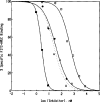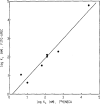2-[2-[4-[2-[2-[ 1,3-Dihydro- 1,1-bis (4-hydroxyphenyl)-3-oxo-5-isobenzofuranthioureidyl]ethylaminocarbonyl]ethyl]phenyl] ethylamino]-5'- N-ethylcarboxamidoadenosine (FITC-APEC): A Fluorescent Ligand For A2a-Adenosine Receptors
- PMID: 23772170
- PMCID: PMC3682427
- DOI: 10.1007/BF00865279
2-[2-[4-[2-[2-[ 1,3-Dihydro- 1,1-bis (4-hydroxyphenyl)-3-oxo-5-isobenzofuranthioureidyl]ethylaminocarbonyl]ethyl]phenyl] ethylamino]-5'- N-ethylcarboxamidoadenosine (FITC-APEC): A Fluorescent Ligand For A2a-Adenosine Receptors
Abstract
The fluorescein conjugate, FITC-APEC (2-[2-[4-[2-[2-[1,3-dihydro-l,l-bis(4-hydroxyphenyl)-3-oxo-5-isobenzofuranthioureidyl]ethylaminocarbonyl]ethyl]phenyl]ethylamino]-5'-N-ethylcarboxamidoadenosine), is a novel ligand derived from a series of functionalized congeners that act as selective A2a-adenosine receptor agonists. The binding of FITC-APEC to bovine striatal A2a,-adenosine receptors measured by fluorescence techniques was saturable and of a high affinity, with a Bmax, of 2.3 ± 0.3 pmol/mg protein and KD of 57 ± 2 nM. The KD value estimated by fluorescence was consistent with the Ki (11 ± 0.3 nM) obtained by competition studies with [3H]CGS 21680. Additionally, the Bmax, value found by FITC-APEC measurement was in agreement with Bmax, values obtained using radioligand binding. FITC-APEC exhibited rapid and reversible binding to bovine striatum. The potencies of chemically diverse A2a-adenosine receptor ligands estimated by inhibition of FITC-APEC binding were in good agreement with their potencies determined using radioligand binding techniques (r = 0.97, P = 0.0003). FITC-APEC binding was not altered by purine derivatives that do not recognize A2a-adenosine receptors. These findings demonstrate that the novel fluorescent ligand FITC-APEC can be used in the quantitative characterization of ligand binding to A2a-adenosine receptors.
Keywords: A2a-adenosine receptors; Fluorescence; bovine striatum; receptor binding.
Figures





Similar articles
-
Evidence for high-affinity binding sites for the adenosine A2A receptor agonist [3H] CGS 21680 in the rat hippocampus and cerebral cortex that are different from striatal A2A receptors.Naunyn Schmiedebergs Arch Pharmacol. 1996 Feb;353(3):261-71. doi: 10.1007/BF00168627. Naunyn Schmiedebergs Arch Pharmacol. 1996. PMID: 8692280
-
A carboxyl-terminally truncated mutant and nonglycosylated A2a adenosine receptors retain ligand binding.Mol Pharmacol. 1994 May;45(5):861-70. Mol Pharmacol. 1994. PMID: 8190103
-
Chemical modification and irreversible inhibition of striatal A2a adenosine receptors.Mol Pharmacol. 1992 Jul;42(1):123-33. Mol Pharmacol. 1992. PMID: 1635550 Free PMC article.
-
Binding of the radioligand [3H]-SCH 58261, a new non-xanthine A2A adenosine receptor antagonist, to rat striatal membranes.Br J Pharmacol. 1996 Apr;117(7):1381-6. doi: 10.1111/j.1476-5381.1996.tb15296.x. Br J Pharmacol. 1996. PMID: 8730729 Free PMC article.
-
Identification of the A2 adenosine receptor binding subunit by photoaffinity crosslinking.Proc Natl Acad Sci U S A. 1989 Sep;86(17):6572-6. doi: 10.1073/pnas.86.17.6572. Proc Natl Acad Sci U S A. 1989. PMID: 2771944 Free PMC article.
Cited by
-
Characterization of binding kinetics of A2AR to Gαs protein by surface plasmon resonance.Biophys J. 2021 May 4;120(9):1641-1649. doi: 10.1016/j.bpj.2021.02.032. Epub 2021 Mar 4. Biophys J. 2021. PMID: 33675761 Free PMC article.
-
Adenosine A1 and A3 Receptors: Distinct Cardioprotection.Drug Dev Res. 2001 Jan-Feb;52(1-2):366-378. doi: 10.1002/ddr.1136. Drug Dev Res. 2001. PMID: 39741902 Free PMC article.
-
Chemical Probes for the Adenosine Receptors.Pharmaceuticals (Basel). 2019 Nov 12;12(4):168. doi: 10.3390/ph12040168. Pharmaceuticals (Basel). 2019. PMID: 31726680 Free PMC article. Review.
-
Synthesis of BODIPY derivatives substituted with various bioconjugatable linker groups: a construction kit for fluorescent labeling of receptor ligands.J Fluoresc. 2014 Jan;24(1):213-30. doi: 10.1007/s10895-013-1289-4. Epub 2013 Sep 20. J Fluoresc. 2014. PMID: 24052460
-
Hydrophilic side chains in the third and seventh transmembrane helical domains of human A2A adenosine receptors are required for ligand recognition.Mol Pharmacol. 1996 Sep;50(3):512-21. Mol Pharmacol. 1996. PMID: 8794889 Free PMC article.
References
-
- Yamamura HI, Enna SJ, Kuhar MJ. Neuro-transmitter Receptor Binding. Raven Press; New York: 1983.
-
- Snyder SH. JAMA. 1989;261:3126–3129. - PubMed
-
- McCabe RT, de Costa BR, Miller RL, Havunjian RH, Rice KC, Skolnick P. FASEB J. 1990;4:2934–2940. - PubMed
-
- Havunjian RH, de Costa BR, Rice KC, Skolnick P. J. Biol. Chem. 1990;265:22181–22186. - PubMed
-
- McCabe RT, Newman AH, Skolnick P. J. Pharmacol. Exp. Ther. 1992;262:734–740. - PubMed
Grants and funding
LinkOut - more resources
Full Text Sources
Other Literature Sources
Miscellaneous
